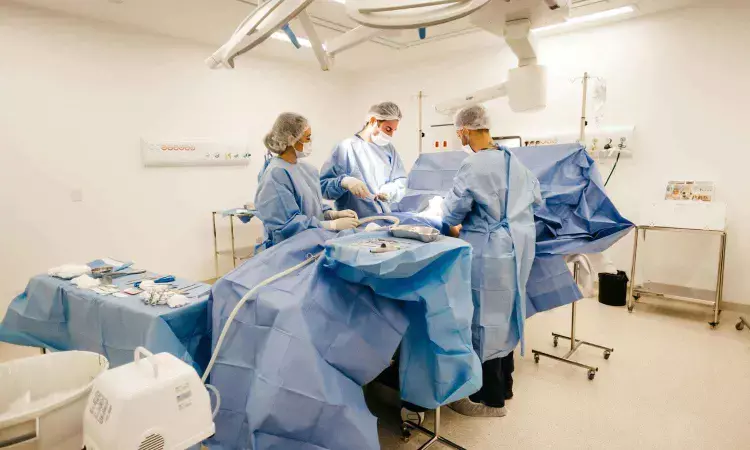- Home
- Medical news & Guidelines
- Anesthesiology
- Cardiology and CTVS
- Critical Care
- Dentistry
- Dermatology
- Diabetes and Endocrinology
- ENT
- Gastroenterology
- Medicine
- Nephrology
- Neurology
- Obstretics-Gynaecology
- Oncology
- Ophthalmology
- Orthopaedics
- Pediatrics-Neonatology
- Psychiatry
- Pulmonology
- Radiology
- Surgery
- Urology
- Laboratory Medicine
- Diet
- Nursing
- Paramedical
- Physiotherapy
- Health news
- Fact Check
- Bone Health Fact Check
- Brain Health Fact Check
- Cancer Related Fact Check
- Child Care Fact Check
- Dental and oral health fact check
- Diabetes and metabolic health fact check
- Diet and Nutrition Fact Check
- Eye and ENT Care Fact Check
- Fitness fact check
- Gut health fact check
- Heart health fact check
- Kidney health fact check
- Medical education fact check
- Men's health fact check
- Respiratory fact check
- Skin and hair care fact check
- Vaccine and Immunization fact check
- Women's health fact check
- AYUSH
- State News
- Andaman and Nicobar Islands
- Andhra Pradesh
- Arunachal Pradesh
- Assam
- Bihar
- Chandigarh
- Chattisgarh
- Dadra and Nagar Haveli
- Daman and Diu
- Delhi
- Goa
- Gujarat
- Haryana
- Himachal Pradesh
- Jammu & Kashmir
- Jharkhand
- Karnataka
- Kerala
- Ladakh
- Lakshadweep
- Madhya Pradesh
- Maharashtra
- Manipur
- Meghalaya
- Mizoram
- Nagaland
- Odisha
- Puducherry
- Punjab
- Rajasthan
- Sikkim
- Tamil Nadu
- Telangana
- Tripura
- Uttar Pradesh
- Uttrakhand
- West Bengal
- Medical Education
- Industry
Dexmedetomidine fails to reduce opioid use, Pain scores or complications among nonintubated ICU Patients with Rib Fracture: Study

Rib fractures are common injuries in critically ill patients and often result in severe pain, impaired ventilation, and a higher risk of pulmonary complications. Optimal analgesic strategies are essential to ensure effective pain control, minimize opioid use, and reduce secondary complications such as pneumonia or respiratory failure.
While dexmedetomidine, a selective α2-adrenergic agonist, has shown opioid-sparing and sedative effects in various ICU populations, its role in nonintubated patients with traumatic rib fractures has remained unclear.
A recent study evaluated whether adjunctive dexmedetomidine could improve outcomes in nonintubated ICU patients with rib fractures. The study measured opioid consumption, pain scores, and the incidence of pulmonary complications such as atelectasis, pneumonia, or respiratory failure.
Researchers found that the addition of dexmedetomidine did not significantly reduce opioid requirements compared to standard analgesic care. Pain scores remained similar between groups throughout the observation period, indicating that dexmedetomidine provided no measurable analgesic advantage in this setting. Furthermore, the incidence of pulmonary complications did not differ between patients receiving dexmedetomidine and those managed with conventional opioid-based analgesia.
These findings suggest that routine use of dexmedetomidine for analgesia in nonintubated ICU patients with rib fractures is not supported by current evidence. While the drug may still have a role in selected patients requiring sedation or with contraindications to opioids, clinicians should not expect it to decrease opioid consumption, improve pain control, or reduce complications as a standard adjunct.
The study underscores the importance of targeted, evidence-based analgesic strategies in critically ill trauma patients. Multimodal pain management, including regional anesthesia techniques, NSAIDs, and judicious opioid use, remains the cornerstone of care for rib fracture patients. Additional research may explore whether specific subgroups, such as elderly patients or those with multiple comorbidities, could benefit from dexmedetomidine.
Reference
Smith, L., Johnson, K., & Patel, R. (2025). Efficacy of dexmedetomidine in nonintubated ICU patients with rib fractures: A randomized controlled study. Critical Care Medicine, 53(7), 945–954. https://doi.org/10.1097/CCM.0000000000005917
Dr. Shravani Dali has completed her BDS from Pravara institute of medical sciences, loni. Following which she extensively worked in the healthcare sector for 2+ years. She has been actively involved in writing blogs in field of health and wellness. Currently she is pursuing her Masters of public health-health administration from Tata institute of social sciences. She can be contacted at editorial@medicaldialogues.in.
Dr Kamal Kant Kohli-MBBS, DTCD- a chest specialist with more than 30 years of practice and a flair for writing clinical articles, Dr Kamal Kant Kohli joined Medical Dialogues as a Chief Editor of Medical News. Besides writing articles, as an editor, he proofreads and verifies all the medical content published on Medical Dialogues including those coming from journals, studies,medical conferences,guidelines etc. Email: drkohli@medicaldialogues.in. Contact no. 011-43720751


